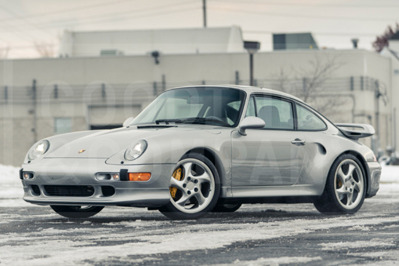Last of the Air-Cooled Warriors
Contrary to how so much of modern society devalues “last” for anything, car collectors often scoop up the last version of a model series because it is the most technically evolved. In most cases over the last 30 or so years, it has usually meant the most powerful and fastest of the series, as well.
Porsche has long been a marque to celebrate its “lasts” as much as or more than its “firsts”. Case in point, the 1995-1997 Porsche 911 Turbo, and especially the Turbo S. The 993 series was the last of the air-cooled 911s. Moreover, Porsche sent the Turbo out with an extra, extra dose of performance and exclusivity.
Porsche made just 345 of its 1995-1997 Turbo S models. If you were not one of the 176 American customers to get one, Gooding & Company is offering a stunning ’97 with 11,400 miles at its Amelia Island sale. The pre-sale estimate is $425k-$475k.

Something in the Air
It’s been more than 20 years since Porsche changed its iconic 911 over to liquid cooling. This means there’s a whole generation of enthusiasts who’ve never seen an air-cooled car in a Porsche showroom. If you’re among them, and you’ve never driven an air-cooled 911, you really need to. It’s the only way to appreciate the character that was lost even as greater performance was gained in the changeover.
The 993 Turbo was a significant leap over its 964 predecessor in every possible way. It offers more power from a twin turbo configuration and other tweaks. This includes all-wheel drive, a 6-speed manual replacing the previous 5-speed, and, naturally, even faster performance.
The “regular” model, as if that word could ever apply to a 911 Turbo, packed a 400-horsepower punch vs. the 360 hp of its predecessor. The twin turbo engine was a torque maven, with a max of 398 lb-ft at 4,500 rpm.
Although weight gain was fairly substantial at about 230 pounds over the previous model, the 1995 Turbo easily shrugged off the added heft: 0-60 fell in under four seconds, and the car could achieve a 180-mph top speed. Few cars could exceed the 911 Turbo’s push in the back under maximum acceleration, but Porsche was determined to try.

Turbo S Power Play
Porsche engineers, you might say, really know how to challenge themselves. The 993 series was on its final lap, and the air-cooled Turbo was coming to the end of a 20-year run. This is not including the unfortunate six-year gap in the American market after 1979. How to give this car a proper send-off?
The Porsche Exclusive department took charge of out-Turbo-ing the Turbo to create the S. Tweaks to the engine management system kicked output of the twin-turbo 3.6-liter flat six up to 424 horsepower and 423 lb-ft of torque. Porsche being Porsche, an additional oil cooler was installed to handle the increased heat. The 0-60 sprint dropped to about 3.5 seconds, and top speed climbed to 184 mph.
The Turbo S Look
The Porsche Exclusive designers were fairly restrained in differentiating the Turbo S from the standard Turbo. Front and rear Aerokit II spoilers, rear fender air inlets and rocker panels that looked almost like mini running boards blended smoothly with the Turbo’s wide-body form.
Up front, the fog lights were deleted, their spaces used to accommodate air ducts for front brake cooling. In the rear, the special exhaust ended in quad tips. Lastly, if you think some of today’s turbocharged sports cars seem a little too muffled, go listen to an air-cooled Porsche 911 Turbo S.

Gotta Have It
The 1995-1997 911 Turbo S was not a stripped down track special. On the contrary, it was a fully equipped GT for the road. Much of what wasn’t slathered in leather was trimmed with carbon fiber, including even the door pulls. Motor Trend complained of extreme squeaking from the leather throughout the cabin. At least the noise could be mostly drowned out by putting your foot down or cranking up the 8-speaker stereo.
Today’s 911 Turbo might have the 1997 model for lunch on a track, but at some point, such comparisons become silly and even rude. The last of the air-cooled 911 Turbos is one of the auto world’s great “gotta have it” cars, and it always will be.

Written by Jim Koscs, Audamotive Communications
For Premier Financial Services



